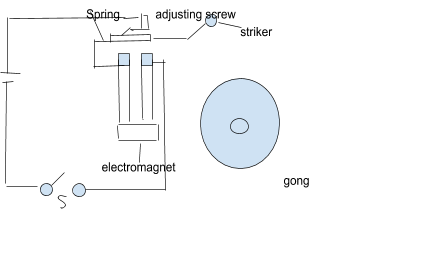
Explain the construction and working of an electric bell with a figure.
Answer
486.3k+ views
Hint: In this question we will study about the electric bell’s working and its construction with the help of diagrams. But firstly, we will understand about the electric bell and the concept behind it and hence this will help us a little more in approaching our answer.
Step-By-Step answer:
An electronic bell or a mechanical bell that works with the means of an electromagnet is known as an electric bell. Electric bells are generally used in schools, railroad crossings, fire, telephones, burglar alarms, alarms in industries, doorbells, etc. In an electric bell an electromagnet’s wire is insulated of coils or consists of coils wound round on iron rods.
An electric bell is constructed by the gong, a soft iron rod, an electromagnet and a contact screw. The electric bell is constructed by the iron core and one end of a coil (a wire) is connected to the terminal of the battery. When the hammer touches the screw, the steel rod acts like a spring and the hammer contacts the other terminal of the battery.

Working of the electric bell – Electric bell has electromagnet in it which has insulated wire coils wound round iron rods. Through the coils when electric current flows the magnetic field is created by the electromagnet which pulls the armature towards it which causes the hammer striking the bell. Hence, due to the flow of an electric current through the coils the rods become magnetic. The piece of an iron which is attached to the clapper attracts the rod. And when that clapper strikes the bell the bell rings.
NOTE: A repetitive buzzing or clanging sound is produced by the electric bell when the current is applied. When the current flows within the coil, a magnetic field is created by the electromagnetic which pulls the armature toward it due to which the hammer strikes the bell.
Step-By-Step answer:
An electronic bell or a mechanical bell that works with the means of an electromagnet is known as an electric bell. Electric bells are generally used in schools, railroad crossings, fire, telephones, burglar alarms, alarms in industries, doorbells, etc. In an electric bell an electromagnet’s wire is insulated of coils or consists of coils wound round on iron rods.
An electric bell is constructed by the gong, a soft iron rod, an electromagnet and a contact screw. The electric bell is constructed by the iron core and one end of a coil (a wire) is connected to the terminal of the battery. When the hammer touches the screw, the steel rod acts like a spring and the hammer contacts the other terminal of the battery.

Working of the electric bell – Electric bell has electromagnet in it which has insulated wire coils wound round iron rods. Through the coils when electric current flows the magnetic field is created by the electromagnet which pulls the armature towards it which causes the hammer striking the bell. Hence, due to the flow of an electric current through the coils the rods become magnetic. The piece of an iron which is attached to the clapper attracts the rod. And when that clapper strikes the bell the bell rings.
NOTE: A repetitive buzzing or clanging sound is produced by the electric bell when the current is applied. When the current flows within the coil, a magnetic field is created by the electromagnetic which pulls the armature toward it due to which the hammer strikes the bell.
Recently Updated Pages
Glucose when reduced with HI and red Phosphorus gives class 11 chemistry CBSE

The highest possible oxidation states of Uranium and class 11 chemistry CBSE

Find the value of x if the mode of the following data class 11 maths CBSE

Which of the following can be used in the Friedel Crafts class 11 chemistry CBSE

A sphere of mass 40 kg is attracted by a second sphere class 11 physics CBSE

Statement I Reactivity of aluminium decreases when class 11 chemistry CBSE

Trending doubts
10 examples of friction in our daily life

The correct order of melting point of 14th group elements class 11 chemistry CBSE

Difference Between Prokaryotic Cells and Eukaryotic Cells

One Metric ton is equal to kg A 10000 B 1000 C 100 class 11 physics CBSE

What is the specific heat capacity of ice water and class 11 physics CBSE

State and prove Bernoullis theorem class 11 physics CBSE




